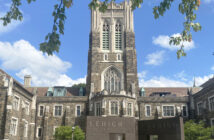As I reflect on my brief time at Lehigh as a sophomore, I’ve often found myself immersed in the sculptures on campus.
We have all passed by the still woman on the bench, or the creepily real man standing near Williams Hall with a red backpack, often mistaking them for real people. And although life-size and human-like, these people have never existed.
Taylor Gym, Maginnes Hall and Mountaintop Campus serve not only as physical spaces but also as resting areas for sculptures. These works of art, characterized by their intrinsic and abstract nature, are an invitation to any student, faculty member or visitor to pause and ponder the significance of the pieces, leaving them to contemplate: “What is this thing?”
Amid this artistry, I cannot help but wonder where the sculptures commemorating real Black individuals are. I mean, after all, we have statues of nameless people.
Has anyone ever considered immortalizing the history and contributions of Black and Brown members of the Lehigh University community?
Recently, I discovered the stories of William Lee Terry, who in the fall of 1884, became the first Black student to attend Lehigh University — whose life ended mysteriously at the age of 19 after his first semester, possibly due to hazing.
Soon after, I learned of Cos Denson, the first Black student to graduate from this institution. His time here was tainted with blatant racism and discrimination, but what did Lehigh do to honor his legacy?
These pivotal figures, whose presence opened the door for many more Black students to be admitted into Lehigh, are nothing but fleeting moments in a vast university history. Their stories are absent from the campus’s collective memory — to this day, their stories await a tangible, public tribute.
Other universities, like the University of Pennsylvania and Baylor University, have chosen to build sculptures of Black individuals on their campuses, sparking vital conversations about the prevailing racial climate on their campuses and in the United States. It may not be perfect, but this is a good start to tackle the racial discrimination so many institutions look to address. When will it be Lehigh’s turn to engage in this meaningful action?
I’m tired of the overused “we see you and we hear you” rhetoric. The time to honor and recognize history through recognizable art is now.
Among the 40-something sculptures on our campus, not one represents the profound experiences and challenges faced by the Black community. None bear witness to the rich history of Black students at Lehigh.
We have sculptures that explore the relationship between spirit and body before we acknowledge the Black student body. Do the stories of Black individuals not deserve a lasting commemoration, too?
As we admire sculptures of Asa Packer, the university’s founder, there exists no such tribute to Terry. His only commemoration is a poetic verse from the Class of 1888, a testament to his brief time on this campus:
We’ll pass the rest of (freshman) year o’er
Except to speak with due respect
Of him who treads the earth no more;
Our classmate who was called away,
To join the choir invisible –
Poor Terry, in his youth’s bright day
We have Chichen Itza White, a sculpture dedicated to the memory of the Holocaust created by Igael Tumarkin in 1986. Interestingly enough, a blue version of the sculpture is displayed at Rutgers University in New Jersey.
While we have that sculpture to remind us of the Holocaust, we lack a sculpture that commemorates the racial incidents that shook our campus in November 2006 with the skinned deer head incident and again in November 2013 with racial vandalism at UMOJA. This demonstrates that commemoration is indeed possible. There have been ongoing discussions about honoring history at Lehigh, yet the stories of Black individuals remain largely overlooked.
UMOJA’s establishment in 1989 was prompted by the tragic murder of Jeanne Cleary by a Black male student. The residence hall was birthed out of an honest dialogue between former student Leon D. Caldwell, ’91, ’93G, and then president, Peter Linkins. It was a part of the university’s efforts to give Black students a safe space on campus.
However, it should not be the sole emblem of honorary recognition and solidarity. There is no one-off solution. The university should strive for continuous initiatives to bring together its Black community. In light of the regrettable racist and discriminatory acts that have occurred on campus, there should be a plethora of commemorations for the Black student population, yet I see none.
I do not suggest that erecting statues alone will eradicate racism. What I propose is that the presence of more sculptures and art honoring the legacies of Black individuals on campus will instigate the vital conversations and honest dialogues necessary to confront the underlying racism at Lehigh and many other universities.
A statue often stands the test of time, living through generations and sparking discussion and reflection. Black history and stories deserve this lasting attention, molding our campus one piece of stone at a time.
Because it is about more than just a statue — more than just art. It is honor.






Comment policy
Comments posted to The Brown and White website are reviewed by a moderator before being approved. Incendiary speech or harassing language, including comments targeted at individuals, may be deemed unacceptable and not published. Spam and other soliciting will also be declined.
The Brown and White also reserves the right to not publish entirely anonymous comments.
2 Comments
The University did establish a major alumni award in honor of Cos Denson, given annually at the Alumni Awards Dinner. Should more be done? Yes. But, it is wrong to say the University has done nothing.
I recently completed an article of the City of Reading High School where William Lee Terry’s name came up. He was the valedictorian of the his high school graduating class in 1884. His life was cut short because of what they called a game of tug and war when it was nothing but murder, plain and simple. Such a travesty of justice. Deplorable. Lehigh should erect a statue to him for the injustice done to this young man.